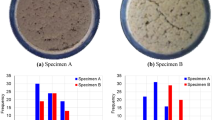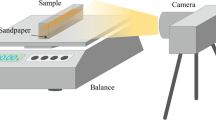Abstract
Soil desiccation cracking is important for a range of engineering applications, but the theoretical advancement of this process is less than satisfactory. In particular, it is not well understood how the crack spacing-to-depth ratio depends on soil material behaviour. In the past, two approaches, namely stress relief and energy balance, have been used to predict the crack spacing-to-depth ratio. The current paper utilises these two approaches to predict the approximate spacing-to-depth ratio of parallel cracks that form in long desiccating soil layers subjected to uniform tensile stress (or suction profile) while resting on a hard base. The theoretical developments have examined the formation of simultaneous and sequential crack patterns and have identified an important relationship between the stress relief and energy approaches. In agreement with experimental observations, it was shown that the spacing-to-depth ratio decreases with layer depth, and crack spacing generally increases with layer depth. The influence of the stiffness at the base interface indicated that decreasing the basal interface stiffness makes the crack spacing to increase in sequential crack formation. The experimental observations also show a decrease in cracking water content with the decrease in layer thickness, and this behaviour was explained on the basis of a critical depth concept.









Similar content being viewed by others
Abbreviations
- \(d\) :
-
Depth of the clay layer
- E :
-
Elastic modulus of clay layer
- \(E_{\text{f}}\) :
-
Energy consumed by crack formation (\(= G_{\text{c}} d\))
- \(E_{\text{f}}^{*}\) :
-
Dimensionless form of \(E_{\text{f}}\)
- G c :
-
Crack energy release rate
- k :
-
Shear stiffness of the interface between clay and hard base
- \(K_{\text{IC}}\) :
-
Fracture toughness in Mode I (pure tensile) cracking
- s :
-
Crack spacing
- u b :
-
Relative displacement at the basal interface
- x :
-
Distance from the crack face
- \(w_{\text{cr}}\) :
-
Water content at crack initiation
- α :
-
Factor of tensile strength needed to from a sequential crack
- Δσ x :
-
Change in normal stress in x direction
- \(\Delta \varepsilon_{x} ,\Delta \varepsilon_{y} ,\Delta \varepsilon_{xy}\) :
-
Change in strain in x and y directions
- \(\Delta U,\Delta U^{*}\) :
-
Change in strain energy and its dimensionless form
- \(\sigma_{x}^{\text{av}} ,\sigma_{y}^{\text{av}} ,\tau_{xy}^{\text{av}}\) :
-
Average normal stresses and shear stresses in x and y directions
- υ :
-
Poisson’s ratio
- τ b :
-
Shear stress at the base of the interface
- σ o :
-
Normal stress prior to cracking
- σ t :
-
Tensile strength of soil
- σ xc :
-
Horizontal stress due to an isolated crack subject to uniform compressive stress
References
Amarasiri AL, Kodikara JK (2013) Numerical modelling of a field desiccation test. Geotechnique 63(11):983–986
Amarasiri AL, Kodikara JK, Costa S (2011) Numerical modelling of desiccation cracking. Int J Numer Anal Methods Geomech 35:82–96
Ayad R, Konrad R-M, Soulié M (1997) Desiccation of sensitive clay: application of the model CRACK. Can Geotech J 34:943–951
Bazant PZ, Cedolin L (1991) Stability of structures. Oxford University Press, Oxford
Chertkov VY, Ravina I (1998) Modelling the crack network of swelling clay soils. Soil Sci Soc Am J 62:1162–1171
Chertkov VY, Ravina I (1999) Morphology of horizontal cracks in swelling soils. Theor Appl Fract Mech 31:19–29
Chertkov VY, Ravina I (2004) Networks originating from the multiple cracking of different scales in rocks and swelling soils. Int J Fract 128:263–270
Chiu RC, Garino TJ, Cima MJ (1993) Drying of granular ceramic films: I effect of processing variables on cracking behaviour. J Am Ceram Soc 76(9):2257–2264
Corte A, Higashi A (1960) Experimental research on desiccation cracks in soil. Research Report, U. S. Army Snow Ice and Permafrost Research Establishment Research Report No. 66, Corps of Engineers. Wilmette, Illinois, USA
Costa S, Htike WY, Kodikara J, Xue J (2016) Determination of J-integral for clay during desiccation. Environmental Geotechnics EG6:372-378
Costa S, Kodikara J, Shannon B (2013) Salient factors controlling desiccation cracking of clay in laboratory experiments. Geotechnique 63(1):18–29
Gui YL, Zhao ZY, Kodikara J, Bui HH, Yang SQ (2016) Numerical modelling of laboratory soil desiccation cracking using UDEC with a mix-mode cohesive fracture model. Eng Geol 202:14–23
Haberfield CM, Johnston IW (1989) Relationship between fracture toughness and tensile strength for geomaterials. In: Proceedings of the 12th international conference on soil mechanics and foundation engineering, Rio de Janeiro, A.A. Balkema, 1:47–52
Huang M, Bruch PG, Barbour SL (2013) Evaporation and water redistribution in layered unsaturated soil profiles. Vadose Zone J 12(1). https://doi.org/10.2136/vzj2012.0108
Itasca Consulting Group (1993) FLAC, Fast Lagrangian Analysis of Continua. Ver: 3.2, Minnesota, USA
Kindle EM (1917) Some factors affecting the development of mud cracks. J Geol 25:135–144
Kodikara JK, Barbour SL, Fredlund DG (2000) Desiccation cracking of soil layers. In: Proceedings of asian conference on unsaturated soils: from theory to practice. Edited by Rahardjo H, Toll DG, Leong EC, A.A. Balkema 693–698
Kodikara JK, Barbour SL, Fredlund DG (2002) Structure development in surficial heavy clay soils: a synthesis of mechanisms. Aust Geomech 37(3):25–40
Kodikara JK, Choi X (2006) A simplified analytical model for desiccation cracking of clay layers in laboratory tests. In: Proceedings of UNSAT 2006 conference. Edited by Miller GA, Zapata CE, Houston SL, Fredlund DG. ASCE Geotechnical Special Publication, Unsaturated Soils, 2:2558–2567
Kodikara JK, Nahlawi H, Bouazza A (2004) Modelling of curling in desiccating clay. Can Geotech J 41:560–566
Konrad J-M, Ayad R (1997) An idealized framework for the analysis of cohesive soils undergoing desiccation. Can Geotech J 34:477–488
Lachenbruch AH (1961) Depth and spacing of tension cracks. J Geophys Res 66(12):4273–4292
Nahlawi H, Kodikara JK (2006) Laboratory experiments on desiccation cracking of thin soil layers. J Geotech Geol Eng 24:1641–1664
Peron H, Hueckel T, Laloui L, Hu LB (2009) Fundamentals of desiccation cracking of fine-grained soils: experimental characterization and mechanisms identification. Can Geotech J 46:1177–1201
Sanchez M, Atique A, Kim S, Romero E, Zielinski M (2013) Exploring desiccation cracks in soils using a 2D profile laser device. Acta Geotech 8:583–596
Shin H, Santamarina JC (2011) Desiccation cracks in saturated fine-grained soils: particle-level phenomena and effective-stress analysis. Geotechnique 61(8):961–972
Thouless MD (1990) Crack spacing in brittle films on elastic substrates. J Am Ceram Soc 73(7):2144–2146
Vo TD, Pouya A, Hemmati S, Tang AM (2017) Numerical modelling of desiccation cracking of clayey soil using a cohesive fracture method. Comput Geotech 85:15–27
Wang JJ, Zhu JG, Chiu CF, Zhang H (2007) Experimental study on fracture toughness and tensile strength of a clay. Eng Geol 94:65–75
White EM (1986) Longevity and effect of tillage-formed soil surface cracks on water infiltration. J Soil Water Conserv 41(5):344–347
Author information
Authors and Affiliations
Corresponding author
Appendix
Appendix
Approximate analytical solution for horizontal stress relief due to an isolated crack in an elastic layer with a hard base.
A solution is presented for a horizontal stress \(\sigma_{xc}\) for the situation depicted in Fig. 1c. The governing equations can be described as follows. The sign convention uses compressive stress as positive and clockwise shear as positive. This is traditional in soil mechanics. For horizontal equilibrium,
where \(\tau_{xy}\) is the shear stress in xy plane. Ignoring normal stress change in y direction and considering plane strain condition, \(\sigma_{\text{xc}}\) can be expressed as:
where u is the shear displacement in x direction. E and \(\nu\) are the Young’s modulus and Poisson’s ratio of the soil, respectively. The shear stress is assumed to follow a linear stress distribution as follows:
where \(\tau_{\text{b}}\) is the shear stress at the basal interface. Assuming a spring of shear stiffness of k to represent the basal interface characteristics, \(\tau_{\text{b}}\) can be related to the shear displacement at the base u b as:
Ignoring the shear strain component associated with vertical displacement, the shear stress \(\tau_{xy}\) can be expressed:
Equations (16), (18) and (19) can be rearranged to give:
Also, Eqs. (18), (19) and (20) can be rearranged to obtain:
Equation (22) can be solved for u by using the boundary condition \(u = u_{\text{b}} , \,y = d.\) Using this result and Eq. (17), it is possible to obtain the following expression from Eq. (21).
Equation (23) can be solved subject to the boundary conditions: \(\sigma_{xc} = \sigma_{0} {\text{ when }}x = 0\); \({\text{and }}\sigma_{xc} \to 0 {\text{ when }}x \to \infty \,\). The solution for \(\sigma_{xc}^{y = 0}\) in non-dimensional form can be expressed as:
Rights and permissions
About this article
Cite this article
Costa, S., Kodikara, J., Barbour, S.L. et al. Theoretical analysis of desiccation crack spacing of a thin, long soil layer. Acta Geotech. 13, 39–49 (2018). https://doi.org/10.1007/s11440-017-0602-9
Received:
Accepted:
Published:
Issue Date:
DOI: https://doi.org/10.1007/s11440-017-0602-9




